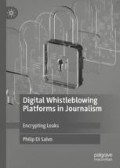Abstract
In addition to igniting other debates, the Snowden case re-sparked a debate concerning the relationship between activism and journalism. Although it was definitely not a completely new issue, it gained new relevance in the wake of the NSA surveillance scandal. Snowden was the starting point for different public discussions among journalists, and one of these focused on balancing potential activists’ stances while conducting aggressive and adversarial investigations, like the one that was conducted on the Snowden files. The debate intensified when the former Executive Editor of the New York Times Bill Keller published an article that was a collection of email exchanges with Glenn Greenwald that took place in the wake of the publication of the first stories based on the Snowden files (Keller 2013). The discussion between the two prominent journalists focused on the differences between Keller’s classic view of objective, balanced reporting and Greenwald’s more adversarial, opinionated while still rigorously fact-oriented style of journalism. Glenn Greenwald in particular has been very vocal in this debate, pushing his stance on journalism in several interviews and public events (Forbes 2014; Greenwald 2014, among others). In an interview with David Carr, in particular, he went straight to his point:
Access this chapter
Tax calculation will be finalised at checkout
Purchases are for personal use only
References
Atton, C. (2009). Alternative and Citizen Journalism. In K. Wahl-Jorgensen & T. Hanitzsch (Eds.), The Handbook of Journalism Studies (pp. 265–278). New York: Routledge.
Atton, C., & Hamilton, J. F. (2008). Alternative Journalism. Thousand Oaks: Sage.
Benkler, Y. (2011). Networks of Power, Degrees of Freedom. International Journal of Communication, 5, 721–755.
Bergamini, O. (2013). La democrazia della stampa. Storia del giornalismo. Roma/Bari: Laterza.
Carr, D. (2013, June 30). Journalism, Even When It’s Tilted. The New York Times. Available from: http://www.nytimes.com/2013/07/01/business/media/journalism-is-still-atwork-even-when-its-practitioner-has-a-slant.html
Dorf, M. C., & Tarrow, S. (2017). Stings and Scams:‘Fake News’, the First Amendment, and the New Activist Journalism. Cornell Legal Studies Research Paper, No. 17–02. Available from: https://ssrn.com/abstract=2906444
Fenton, N. (2010). NGOs, New Media and the Mainstream News: News from Everywhere. In New Media, Old News: Journalism & Democracy in the Digital Age (pp. 53–168). Thousands Oaks: Sage.
Forbes, M. (2014, August). Glenn Greenwald Aagainst the World. Columbia Journalism Review. Available from: http://archives.cjr.org/critical_eye/glenn_greenwald_against_the_wo.php
Ganesh, M. I., & Hankey, S. (2015). From Information Activism to the Politics of Data. The Fibreculture Journal, 26, 275–286.
Gieryn, T. F. (1983). Boundary-Work and the Demarcation of Science from Non-Science: Strains and Interests in Professional Ideologies of Scientists. American Sociological Review, 48(6), 781–795.
Gillmor, D. (2015, April 18). Why Journalists Should (at Least Sometimes) Be Activists. Dangillmor.com. Available from: https://dangillmor.com/2015/04/18/why-journalists-should-be-activists-atleast-some-of-the-time/
Greenwald, G. (2014). No Place to Hide. Edward Snowden, the NSA, and the US Surveillance State. New York: Metropolitan Books.
Jeppesen, L. (2016). Direct-Action Journalism: Resilience in Grassroots Autonomous Media. Journal of Applied Journalism & Media Studies, 5(3), 383–403.
Keller, B. (2013, October 27). Is Glenn Greenwald the Future of News? The New York Times. Available from: http://www.nytimes.com/2013/10/28/opinion/a-conversation-in-lieu-of-acolumn.html
Lewis, S. C. (2012). The Tension Between Professional Control and Open Participation: Journalism and Its Boundaries. Information, Communication and Society, 15(6), 836–866.
Lewis, S. C., & Usher, N. (2014). Code, Collaboration, and the Future of Journalism: A Case Study of the Hacks/Hackers Global Network. Digital Journalism, 2(3), 383–393.
Lievrouw, L. (2011). Alternative and Activist New Media. Cambridge: Polity.
Milan, S. (2013). Social Movements and Their Technologies: Wiring Social Change. Basingstoke: Palgrave Macmillan.
Milan, S., & van der Velden, L. (2016). The Alternative Epistemologies of Data Activism. Digital Culture and Society, 2(1), 57–74.
Powers, M. (2016). The New Boots on the Ground: NGOs in the Changing Landscape of International News. Journalism, 17(4), 401–416.
Riordan, K. (2014). Accuracy, Independence, and Impartiality: How Legacy Media and Digital Natives Approach Standards in the Digital Age. Reuters Insitute for the Study of Journalism. Available from: https://reutersinstitute.politics.ox.ac.uk/our-research/accuracyindependence-and-impartiality-how-legacy-media-and-digital-nativesapproach
Ruigrok, N. (2010). From Journalism of Activism Towards Journalism of Accountability. International Communication Gazette, 72(1), 85–90.
Russell, A. (2016). Journalism as Activism: Recoding Media Power. London: Polity.
Sandoval, M., & Fuchs, C. (2010). Towards a Critical Theory of Alternative Media. Telematics and Informatics, 27, 141–150.
Singer, J. B. (2008). The Journalist in the Network: A Shifting Rationale for the Gatekeeping Role and the Objectivity Norm. Trípodos. Facultat de Comunicació I Relacions Internacionals Blanquerna, 23, 61–76.
Singer, J. (2015). Out of Bounds: Professional Norms as Boundary Markers. In M. Carlson & S. C. Lewis (Eds.), Boundaries of Journalism: Professionalism, Practices and Participation (pp. 21–36). Oxford: Routledge.
Vine, P. (2017). When Is a Journalist Not a Journalist?: Negotiating a New Form of Advocacy Journalism within the Environmental Movement. Pacific Journalism Review, 23(1), 43.
Waisbord, S. (2011). Can NGOs Change the News? International Journal of Communication, 5, 142–165.
Author information
Authors and Affiliations
Corresponding author
Rights and permissions
Copyright information
© 2020 The Author(s)
About this chapter
Cite this chapter
Di Salvo, P. (2020). The Boundary Space Between Journalism and Activism. In: Digital Whistleblowing Platforms in Journalism. Palgrave Macmillan, Cham. https://doi.org/10.1007/978-3-030-38505-7_7
Download citation
DOI: https://doi.org/10.1007/978-3-030-38505-7_7
Published:
Publisher Name: Palgrave Macmillan, Cham
Print ISBN: 978-3-030-38504-0
Online ISBN: 978-3-030-38505-7
eBook Packages: Literature, Cultural and Media StudiesLiterature, Cultural and Media Studies (R0)

